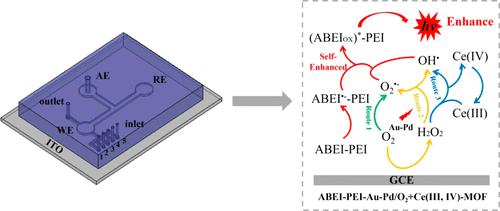当前位置:
X-MOL 学术
›
Anal. Chem.
›
论文详情
Our official English website, www.x-mol.net, welcomes your
feedback! (Note: you will need to create a separate account there.)
Efficient ABEI–Dissolved O2–Ce(III, IV)-MOF Ternary Electrochemiluminescent System Combined with Self-Assembled Microfluidic Chips for Bioanalysis
Analytical Chemistry ( IF 6.7 ) Pub Date : 2022-06-18 , DOI: 10.1021/acs.analchem.2c01199 Xianzhen Song 1 , Siqi Yu 2 , Lu Zhao 1 , Yujian Guo 1 , Xiang Ren 1 , Hongmin Ma 1 , Shoufeng Wang 1 , Chuannan Luo 1 , Yuyang Li 1 , Qin Wei 1, 3
Analytical Chemistry ( IF 6.7 ) Pub Date : 2022-06-18 , DOI: 10.1021/acs.analchem.2c01199 Xianzhen Song 1 , Siqi Yu 2 , Lu Zhao 1 , Yujian Guo 1 , Xiang Ren 1 , Hongmin Ma 1 , Shoufeng Wang 1 , Chuannan Luo 1 , Yuyang Li 1 , Qin Wei 1, 3
Affiliation

|
A signal-amplified electrochemiluminescent (ECL) sensor chip was developed for sensitive analysis of procalcitonin (PCT). Herein, we first prepared a self-enhanced luminophore, which enhanced ECL responses through intramolecular reactions. Second, Au–Pd bimetallic nanocrystals and mixed-valence Ce-based metal–organic frameworks (MOFs) were introduced as co-reaction promoters to facilitate the reduction of dissolved O2. Based on the synergistic catalysis of Au and Pd, the spontaneous cyclic reaction of Ce(III)/Ce(IV), and the high electrochemical active surface area of Ce(III, IV) MOF, a large number of superoxide anion radicals (O2•–) and hydroxyl radicals (OH•) were produced. Therefore, the luminescence efficiency of N-(aminobutyl)-N-(ethylisoluminol)–dissolved O2 (ABEI–O2) systems were greatly improved, providing a new prospect for the application of dissolved O2 in ECL analysis. In addition, the affinity peptide ligands were used for the directional connection of antibodies to provide protection for the bioactivity of the proposed sensor. Finally, the microfluidic technology was applied to ECL analysis to integrate the three-electrode detection system into the self-assembled microfluidic chip, which realized the automation and portability of the detection process. The developed sensor showed high sensitivity for PCT detection with a detection limit of 3.46 fg/mL, which possessed positive significance for the clinical diagnosis of sepsis.
中文翻译:

高效ABEI-溶解O2-Ce(III, IV)-MOF三元电化学发光系统结合自组装微流控芯片进行生物分析
开发了一种信号放大电化学发光 (ECL) 传感器芯片,用于对降钙素原 (PCT) 进行灵敏分析。在这里,我们首先制备了一种自增强发光体,它通过分子内反应增强 ECL 响应。其次,引入Au-Pd双金属纳米晶体和混合价Ce基金属-有机骨架(MOF)作为共反应促进剂,以促进溶解的O 2的还原。基于 Au 和 Pd 的协同催化、Ce(III)/Ce(IV) 的自发循环反应以及 Ce(III,IV) MOF 的高电化学活性表面积,大量超氧阴离子自由基(O 2 •– ) 和羟基自由基(OH • ) 产生。因此,N的发光效率-(氨基丁基) -N- (乙基异鲁米诺)-溶解O 2 (ABEI-O 2 )体系得到很大改进,为溶解O 2在ECL分析中的应用提供了新的前景。此外,亲和肽配体用于抗体的定向连接,为所提出的传感器的生物活性提供保护。最后将微流控技术应用于ECL分析,将三电极检测系统集成到自组装微流控芯片中,实现了检测过程的自动化和便携化。所研制的传感器对PCT检测具有较高的灵敏度,检出限为3.46 fg/mL,对脓毒症的临床诊断具有积极意义。
更新日期:2022-06-18
中文翻译:

高效ABEI-溶解O2-Ce(III, IV)-MOF三元电化学发光系统结合自组装微流控芯片进行生物分析
开发了一种信号放大电化学发光 (ECL) 传感器芯片,用于对降钙素原 (PCT) 进行灵敏分析。在这里,我们首先制备了一种自增强发光体,它通过分子内反应增强 ECL 响应。其次,引入Au-Pd双金属纳米晶体和混合价Ce基金属-有机骨架(MOF)作为共反应促进剂,以促进溶解的O 2的还原。基于 Au 和 Pd 的协同催化、Ce(III)/Ce(IV) 的自发循环反应以及 Ce(III,IV) MOF 的高电化学活性表面积,大量超氧阴离子自由基(O 2 •– ) 和羟基自由基(OH • ) 产生。因此,N的发光效率-(氨基丁基) -N- (乙基异鲁米诺)-溶解O 2 (ABEI-O 2 )体系得到很大改进,为溶解O 2在ECL分析中的应用提供了新的前景。此外,亲和肽配体用于抗体的定向连接,为所提出的传感器的生物活性提供保护。最后将微流控技术应用于ECL分析,将三电极检测系统集成到自组装微流控芯片中,实现了检测过程的自动化和便携化。所研制的传感器对PCT检测具有较高的灵敏度,检出限为3.46 fg/mL,对脓毒症的临床诊断具有积极意义。











































 京公网安备 11010802027423号
京公网安备 11010802027423号